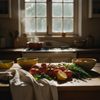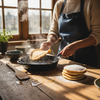Broil Hamburgers Like a Pro: 5 Essential Tips
Why Broil Hamburgers? The Indoor Grilling Game-Changer
Picture this: It's Tuesday night, you're craving that perfect burger, but it's pouring rain outside and your grill is basically a small swimming pool. Enter broiling-your secret weapon for achieving that coveted char and juicy interior without stepping foot outdoors. When you broil hamburgers, you're essentially grilling upside down, using your oven's top heating element to create intense, direct heat that rivals any backyard setup.
Key Takeaways
- Broiling hamburgers allows you to achieve a grilled taste indoors, regardless of weather conditions.
- Using the oven's top heating element provides intense, direct heat similar to outdoor grilling.
- Broiling is an effective alternative to outdoor grilling when conditions are unfavorable.
- This method helps create a perfect char while keeping the burger juicy inside.
Table of Contents
- Why Broil Hamburgers? The Indoor Grilling Game-Changer
- Broiling vs. Other High-Heat Cooking Methods
- Essential Broiling Equipment and Setup
- The Best Ingredients for Broiled Burgers
- Step-by-Step: How to Broil Hamburgers Like a Pro
- Mastering Broiling Times and Temperatures
- Troubleshooting Common Broiling Problems
- Creative Variations and Serving Ideas
- Serving Suggestions and Storage
- Your Path to Broiled Burger Mastery
Here's the thing: broiling isn't just a backup plan-it's a legitimate cooking method that delivers restaurant-quality results in your own kitchen. The high heat (we're talking 500°F+) creates that beautiful Maillard reaction on the surface while keeping the interior tender and juicy. Plus, you get consistent results every single time, rain or shine.
Quick Answer
To broil hamburgers, preheat your broiler on high, place seasoned ¼-pound patties on a broiler pan 3-4 inches from the heating element, and broil for 3-4 minutes per side for medium doneness (140-150°F internal temperature). Use 85/15 ground beef for the best balance of flavor and juiciness.
Broiling vs. Other High-Heat Cooking Methods

Let's break down how broiling stacks up against your other burger-making options. Understanding these differences will help you choose the right method for your situation and desired results.
| Method | Heat Source | Key Features | Best For |
|---|---|---|---|
| Broiling | Top (oven element) | Intense, direct heat; quick sear | Speed, indoor cooking, consistent results |
| Grilling | Below (outdoor grill) | Open flame, smoky flavor | Outdoor flavor, large batches, entertaining |
| Pan-frying | Bottom (stovetop) | Surface sear, moderate cleanup | Small batches, precise control |
| Baking | Indirect (oven) | Even, slow cooking, no sear | Large batches, hands-off cooking |
When to choose broiling: You want that grilled flavor and texture but need the convenience of indoor cooking. It's perfect for weeknight dinners, small batches, or when weather isn't cooperating with your outdoor plans.
Essential Broiling Equipment and Setup
Success starts with the right setup. You don't need fancy equipment, but choosing the right tools makes all the difference between burger perfection and a smoky kitchen disaster.
Your Broiler Pan Options
The classic broiler pan-that two-piece setup with a slotted top and drip tray-is your best friend here. The slots allow fat to drain away, preventing flare-ups and ensuring even cooking. No broiler pan? A cast iron skillet works beautifully and actually gives you better heat retention and an even more intense sear.
Avoid using thin cookie sheets-they'll warp under the intense heat and give you uneven results. If you must use a regular baking sheet, line it with heavy-duty foil and create a slight rim to contain any drippings.
Pro Tip: Whatever pan you choose, lightly oil it or use cooking spray to prevent sticking. Your future self will thank you during cleanup.
Getting the Distance Right
Position matters-a lot. Place your oven rack 3-4 inches below the broiler element. Too close, and you'll char the outside before the inside cooks. Too far, and you lose that intense searing power that makes broiling special.
Most ovens have a broiler setting that automatically heats to around 500°F, but some require you to preheat with the door slightly ajar. Check your oven manual-this small detail can make or break your burger game.
"The key to perfect broiled burgers is understanding your oven's personality. Some broilers run hotter than others, so your first batch is always a learning experience. Take notes on timing and positioning-you'll nail it by the second round." - Test Kitchen Insight
The Best Ingredients for Broiled Burgers

Great broiled burgers start with great ingredients. While technique matters, your choice of meat, seasonings, and toppings can elevate a simple burger into something memorable.
Choosing Your Ground Beef
Here's where 85/15 ground beef shines. That 15% fat content is the sweet spot-enough to keep your burgers juicy under the intense broiler heat, but not so much that you're dealing with excessive flare-ups. Chuck is ideal because it has the perfect balance of flavor and fat distribution.
Going leaner? You can use 90/10, but watch your timing closely and consider adding a bit of moisture with finely minced onions or a splash of Worcestershire sauce mixed into the meat.
Building Your Signature Seasoning Blend
The beauty of broiled burgers lies in how quickly they develop that gorgeous crust-which means your seasonings get intensified and caramelized in record time. Start with the holy trinity: salt, pepper, and garlic powder. From there, onion powder adds depth, while paprika (smoked if you're feeling adventurous) brings color and a subtle warmth.
Essential Seasoning Ratio: For every pound of ground beef, use 1 teaspoon salt, ½ teaspoon black pepper, ½ teaspoon garlic powder, ½ teaspoon onion powder, and ¼ teaspoon paprika.
Want to get creative? Cumin and chili powder transform your burger into a Southwestern masterpiece. Fresh herbs like thyme or oregano work beautifully too, but add them to the meat mixture rather than just sprinkling on top-the broiler's intense heat can burn delicate herbs if they're exposed.
Cheese That Actually Melts Under Pressure
Not all cheeses are created equal under the broiler's intense heat. You need varieties that melt smoothly without separating or burning. Gouda is phenomenal-it melts like a dream and adds a subtle smokiness that complements the broiled flavor. Sharp cheddar brings that classic burger taste, while pepper jack adds a kick that plays beautifully with the caramelized meat.
Here's a pro move: add your cheese during the last minute of broiling. This gives it just enough time to melt and bubble without burning or becoming rubbery.
Step-by-Step: How to Broil Hamburgers Like a Pro
Ready to put theory into practice? This method has been tested countless times in real kitchens, and it delivers consistent, restaurant-quality results every time.
Shaping and Seasoning Your Patties
- Divide your ground beef into equal portions-¼ to ⅓ pound each works perfectly for standard burger buns
- Gently shape into discs about ½ inch thick, making them slightly wider than your buns (they'll shrink during cooking)
- Create a small dimple in the center of each patty with your thumb-this prevents the dreaded burger dome
- Season both sides generously, pressing the seasonings gently into the meat
Critical Technique: Handle the meat as little as possible. Overworking creates tough, dense burgers that no amount of perfect timing can save.
The Broiling Process
Preheat your broiler on high-most ovens need about 5 minutes to reach full intensity. Place your seasoned patties on your prepared broiler pan, leaving space between each one for even heat circulation.
Here's where timing becomes crucial: broil hamburgers in oven for 3-4 minutes on the first side. You'll hear them sizzle immediately-that's the sound of success. Flip once (and only once) using a sturdy spatula, then broil for another 3-4 minutes for medium doneness.
Broiling Timeline at a Glance
- Medium-rare (130-135°F): 3 minutes per side
- Medium (140-150°F): 3-4 minutes per side
- Well-done (160°F+): 5-6 minutes per side
During the last minute of cooking, add your cheese slices and let the residual heat work its magic. The cheese should be melted and slightly bubbly when you remove the pan.
The Rest and Assembly
This step separates good cooks from great ones: let your burgers rest for 3-5 minutes after broiling. This allows the juices to redistribute throughout the meat, ensuring every bite is as juicy as the last.
While the burgers rest, quickly toast your buns under the broiler-30-60 seconds cut-side up is all you need. The slight char adds texture and helps prevent soggy bottoms when you add condiments.
"The biggest mistake I see home cooks make is cutting into their burgers immediately after cooking. Those precious juices you worked so hard to develop? They'll end up on your cutting board instead of in your mouth." - Culinary Institute Graduate
Mastering Broiling Times and Temperatures

Understanding what temp to broil burgers in oven and for how long is the difference between burger perfection and disappointment. Most broilers operate at around 500°F, but the key is knowing when your specific setup reaches that sweet spot of doneness.
| Doneness Level | Internal Temperature | Total Broiling Time | Characteristics |
|---|---|---|---|
| Medium-Rare | 130-135°F | 6-7 minutes | Pink center, very juicy |
| Medium | 140-150°F | 7-9 minutes | Slightly pink, juicy |
| Medium-Well | 150-160°F | 9-12 minutes | Little pink, still moist |
| Well-Done | 160°F+ | 12-15 minutes | No pink, firm texture |
Food Safety Note: The USDA recommends cooking ground beef to 160°F for safety. However, many chefs and home cooks prefer medium doneness (140-150°F) when using high-quality, fresh ground beef from trusted sources.
The Meat Thermometer Advantage
Invest in a good instant-read thermometer-it's the most reliable way to achieve consistent results. Insert it horizontally into the thickest part of the patty, avoiding any fat pockets that might give false readings.
Remember, the temperature will continue to rise slightly after you remove the burgers from the broiler, so you can pull them when they're about 5 degrees below your target temperature.
Troubleshooting Common Broiling Problems
Even experienced cooks encounter challenges when learning to broil hamburgers in oven. The good news? Most issues have simple solutions that'll have you flipping perfect patties in no time.
Most Common Issue: Burgers that are charred outside but raw inside. This happens when your oven rack is too close to the broiler element-move it down one position and extend cooking time slightly.
When Burgers Turn Out Dry
Dry burgers are usually the result of using lean ground beef (90/10 or higher) or overcooking. The intense heat of broiling can quickly evaporate moisture, especially from lean cuts. Stick with 85/15 ground beef, and remember that ground meat continues cooking from residual heat even after you remove it from the broiler.
Another culprit? Pressing down on patties while they cook. Resist the urge-you're literally squeezing out the juices you want to keep.
Solving Sticking Problems
Nothing's more frustrating than having your perfectly seasoned patty fall apart when you try to flip it. The solution is twofold: proper pan preparation and patience. Lightly oil your broiler pan or line it with foil, and wait the full 3-4 minutes before attempting your first flip. The proteins need time to set and release naturally.
Pro Technique: If a patty resists flipping, give it another 30-60 seconds. Forced flipping leads to torn, uneven burgers.
| Problem | Likely Cause | Quick Fix |
|---|---|---|
| Excessive smoke | Fat dripping onto broiler element | Use broiler rack, trim excess fat |
| Uneven cooking | Patties different thicknesses | Use kitchen scale for consistent portions |
| Cheese burns before melting | Added too early | Add during final 60 seconds only |
| Burgers shrink excessively | No dimple, overworked meat | Create center dimple, handle gently |
Creative Variations and Serving Ideas
Once you've mastered the basics of how long to broil burgers in oven, it's time to get creative. The beauty of broiling is how it intensifies flavors, making it perfect for bold seasoning combinations and unique toppings.
International Flavor Profiles
Transform your basic burger into a global experience with these tested combinations. For Mediterranean-style burgers, mix oregano, dried mint, and a touch of cinnamon into your ground beef, then top with feta and tzatziki. The broiler's high heat caramelizes these herbs beautifully without burning them.
Asian-inspired burgers work phenomenally under the broiler too. Add ginger powder, soy sauce, and a pinch of five-spice to your meat mixture. Top with sharp cheddar (it pairs surprisingly well) and serve on toasted brioche with sriracha mayo.
Flavor Combination Ideas
- Southwest: Cumin, chili powder, smoked paprika + pepper jack cheese
- Italian: Basil, oregano, garlic powder + mozzarella
- BBQ: Brown sugar, smoked paprika, onion powder + sharp cheddar
- Cajun: Cayenne, thyme, paprika + Gouda
Beyond Beef: Alternative Proteins
Ground turkey and chicken broil beautifully, though they require slight timing adjustments. These leaner proteins cook faster-start checking doneness at 2-3 minutes per side. The key is adding moisture through ingredients like grated onion or a tablespoon of olive oil mixed into the meat.
Lamb burgers are exceptional under the broiler. The high heat brings out lamb's natural richness while creating an incredible crust. Season with rosemary, garlic, and a touch of mint, then serve with goat cheese for an elevated experience.
"The broiler's intense heat makes it ideal for proteins that benefit from quick searing. I've had incredible success with lamb, turkey, and even salmon burgers-just adjust your timing and don't walk away." - James Beard Award Winner
Serving Suggestions and Storage
The perfect broiled burger deserves thoughtful accompaniments. Classic sides like crispy fries or onion rings complement the intense, caramelized flavors that broiling creates. But don't overlook lighter options-a crisp coleslaw or arugula salad provides excellent contrast to rich, broiled meat.
Assembly for Maximum Impact
Build your burger strategically: start with a lightly toasted bottom bun, add your condiments (this creates a moisture barrier), then lettuce, tomato, your perfectly broiled patty with melted cheese, and finally the top bun. This order prevents sogginess and ensures every component shines.
For storage, cooked burger patties keep in the refrigerator for 3-4 days. Reheat gently in a 300°F oven for 5-7 minutes rather than microwaving-this preserves texture and prevents rubberiness.
Make-Ahead Tip: You can shape and season patties up to 24 hours in advance. Store them covered in the refrigerator with parchment paper between layers to prevent sticking.
Your Path to Broiled Burger Mastery
Learning to broil hamburgers opens up a world of quick, flavorful cooking that doesn't depend on weather or outdoor space. With the right technique-proper rack positioning, quality 85/15 ground beef, strategic seasoning, and careful timing-you'll create restaurant-quality burgers that rival any grill.
Remember the fundamentals: preheat your broiler fully, use the dimple technique to prevent doming, flip only once, and always let your burgers rest before serving. These simple steps, combined with quality ingredients and a bit of practice, will have you creating memorable meals that bring people together around your table.
The beauty of broiling lies in its consistency and convenience-once you master these techniques, you'll have perfectly juicy, flavorfully crusted burgers ready in under 10 minutes, any day of the year. Now grab that DI ORO™ spatula and start flipping your way to burger perfection.
Frequently Asked Questions
How long does it take to broil burgers?
Broiling burgers typically takes about 4 to 6 minutes per side, depending on the thickness of your patties and desired doneness. Keep a close eye to avoid overcooking, as broilers deliver intense, direct heat from above.
Is it better to broil or bake hamburger patties?
Broiling is generally better for hamburger patties when you want that quick sear and caramelized crust because it uses direct high heat from above. Baking cooks more gently and evenly but won’t give you the same browning or that crave-worthy crust on your burgers.
What is the 5 6 7 rule for burgers?
The 5-6-7 rule is a simple timing guide for cooking burgers: 5 minutes on the first side, 6 minutes on the second, and 7 minutes total to reach a perfectly cooked patty, usually medium to medium-well. This rule helps balance cooking time to achieve juicy results without guessing.
What is the best oven setting for burgers?
The best oven setting for burgers is the broil mode on high, which exposes the meat to intense, direct heat from above. This setting mimics grilling by creating a nicely browned exterior while keeping the inside juicy, perfect for that restaurant-quality burger at home.
How many minutes should you broil?
You should broil burgers for about 4 to 6 minutes per side, totaling roughly 8 to 12 minutes depending on thickness and doneness preference. Always watch closely, as broiling can quickly go from perfectly seared to overdone.
How does burger King broil their burgers?
Burger King broils their burgers using an open-flame broiler that cooks the patty with direct heat from above and below, creating those signature flame-grilled char marks and smoky flavor. This method delivers a seared exterior and juicy interior, setting their burgers apart from standard pan-fried or baked versions.




